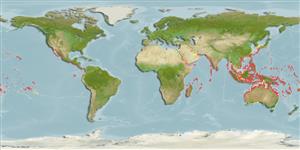>
Eupercaria/misc (Various families in series Eupercaria) >
Labridae (Wrasses) > Xyrichtyinae
Etymology: Iniistius: Latin, in = in + Greek, istion = sail.
More on author: Linnaeus.
Environment: milieu / climate zone / depth range / distribution range
นิเวศวิทยา
เกี่ยวกับทะเล,น้ำเค็ม เกี่ยวกับหินโสโครก; ระดับความลึก 2 - 30 m (Ref. 90102). Tropical
Indo-Pacific: Red Sea and East Africa to the Pacific.
ขนาด / น้ำหนัก / Age
Maturity: Lm ? range ? - ? cm
Max length : 25.0 cm TL เพศผู้/กระเทย; (Ref. 2334)
Short description
เครื่องมือที่ใช้ในการแยกชนิดสัตว์,สิ่งมีชีวิตออกจากกัน | สัณฐานวิทยา | ความยาวต่างๆ
เงี่ยงครีบหลัง (รวม) : 9; ก้านครีบอ่อนที่หาง (รวม) : 12; เงี่ยงครีบก้น: 3; ก้านครีบอ่อนที่ก้น: 12 - 13.
Found over sandy bottoms of coastal areas and also in areas with some seagrass or algae. Ranges to a depth of over 18 m (Ref. 9710). Usually in large spread-out groups on upper slopes of sand and mud banks with males defending its section that has numerous females (Ref. 48636). Dives into sand to sleep safely at night or to hide when alarmed (Ref. 90102). When threatened, it dives head-first into sand; may take some time to emerge again. Feeds mainly on hard-shelled prey, including mollusks and crustaceans (Ref. 5374). Minimum depth taken from Ref. 9710.
Life cycle and mating behavior
Maturities | การสืบพันธุ์ | Spawnings | Egg(s) | Fecundities | ตัวอ่อน
Pelagic spawner.
Randall, J.E., G.R. Allen and R.C. Steene, 1990. Fishes of the Great Barrier Reef and Coral Sea. University of Hawaii Press, Honolulu, Hawaii. 506 p. (Ref. 2334)
IUCN Red List Status (Ref. 130435)
Threat to humans
Harmless
Human uses
การประมง: มีการค้าเพียงเล็กน้อย; สถานที่แสดงสัตว์และพืชน้ำ: การค้า
เครื่องมือ
Special reports
Download XML
แหล่งที่มาจากอินเตอร์เน็ต
Estimates based on models
Preferred temperature (Ref.
123201): 24.4 - 29.3, mean 28.3 °C (based on 3300 cells).
Phylogenetic diversity index (Ref.
82804): PD
50 = 0.5000 [Uniqueness, from 0.5 = low to 2.0 = high].
Bayesian length-weight: a=0.01023 (0.00397 - 0.02640), b=3.06 (2.84 - 3.28), in cm total length, based on LWR estimates for this (Sub)family-body shape (Ref.
93245).
ระดับชั้นอาหาร (Ref.
69278): 3.6 ±0.50 se; based on food items.
ความสามารถในการกลับคืนสู่ปกติ (Ref.
120179): ขนาดกลาง, เวลาต่ำสุดที่จะทำให้ประชากรเพิ่มขึ้นเป็น 2 เท่าใช้เวลา 1.4 - 4.4 ปี (Preliminary K or Fecundity.).
Fishing Vulnerability (Ref.
59153): Low vulnerability (15 of 100).
Nutrients (Ref.
124155): Calcium = 60.7 [37.1, 98.7] mg/100g; Iron = 0.619 [0.367, 1.115] mg/100g; Protein = 18.6 [15.7, 20.8] %; Omega3 = 0.146 [0.097, 0.220] g/100g; Selenium = 25.1 [15.8, 43.5] μg/100g; VitaminA = 124 [39, 440] μg/100g; Zinc = 1.45 [1.02, 2.23] mg/100g (wet weight);
